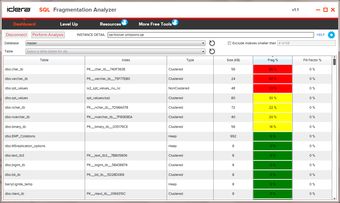Identify index fragmentation in databases and tables
Identifying index fragmentation in databases and database tables is of significant importance to maintaining optimal query performance and efficient system resource usage. Index fragmentation can negatively affect read and write operations, causing slower data retrieval and worsening system response times. This slower response can lead to an overall subpar user experience and negatively affect business operations that rely on timely data access. By identifying and managing index fragmentation, organizations can ensure that indexes are providing the maximum benefit, improving data retrieval speed and efficiency. Additionally, addressing fragmentation helps optimize storage use, enhances system stability, and reduces the workload on the server, leading to a more resilient and performance-tuned database system.
- Analyze fragmentation by one table or an entire database
- Identify databases in need of defragmentation
- Set fragmentation thresholds: normal, warning, critical
- Connect to cloud and run in cloud (provisional)
Analyze Fragmentation
An easy to view graphical representation of fragmentation levels across your SQL Servers shows index type, fragmentation percentages, size and fill-factor so users can spot immediately what given area needs attention.
Highlight Fragmentation
With SQL fragmentation analyzer’s color coded graph, quickly identify the databases containing the highest fragmentation levels. View fragmentation levels for an entire database or a specific table.
Customize Thresholds
Determine and set thresholds for fragmentation levels including what levels to consider unacceptable. Specify normal, warning, and critical levels based upon our recommendations or implement your own best practices.
Connect to Cloud and Run in Cloud (Provisional)
Connect to database instances hosted in the cloud, such as SQL Server on Azure Virtual Machine (VM), SQL Server on Amazon Elastic Compute Cloud (EC2), and SQL Server on Amazon Relational Database Service (RDS).
Run on virtual machines hosted in the cloud, such as Windows on Azure Virtual Machine (VM) and Windows on Amazon Elastic Compute Cloud (EC2).
SQL Fragmentation Analyzer
